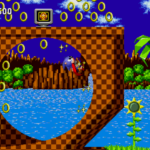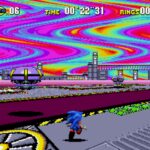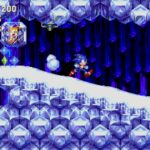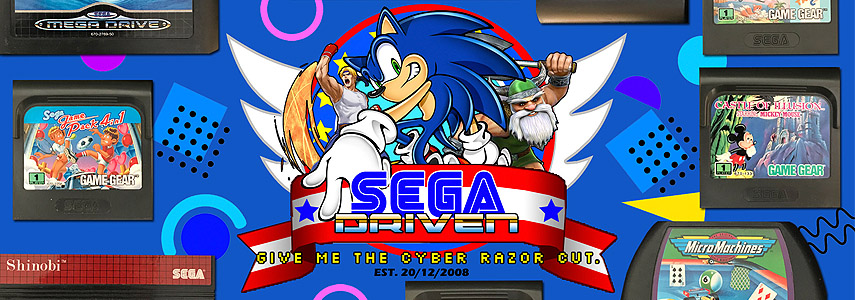Sonic Origins – Switch Review
SEGA aren’t exactly strangers to wheeling out the Classic Sonic games now. It’s a running joke amongst the fanbase that every Sonic fan owns at least 30 different copies of the original game across just about every gaming platform known to man. Hell – I had Sonic the Hedgehog on my chunky old iPod Classic! But after the rather staggering way SEGA stuffed up Sonic Colours Ultimate last year, I don’t think it’s unreasonable that some people were even more wary of Sonic Origins than they’d usually be. The good news is that this isn’t the mess that Sonic’s Wii outing got turned into. The bad news is that Sonic Origins is still a very flawed package, full of glaring errors and mistakes that are made more aggravating knowing they could’ve been very easily fixed.
The key difference between Origins and previous releases such as Sonic Mega Collection is that these versions use Christian Whitehead’s Retro Engine and are based on ports that until now were mostly restricted to mobile devices. Every game has a consistent 60fps performance, with widescreen support and smoothed out control – it’s not some cheap imitation of Classic Sonic’s gameplay as certain other titles in the series have been, and everything feels as it should physics-wise. At their core, these are the absolute best versions of the Classic Sonic games, and having them on something besides a mobile phone is wonderful.
Sonic Team has gone in and made some further adjustments however, and while some are nice to have, some miss the mark. Each game offers two modes of play – Anniversary Mode and Classic Mode. In Anniversary Mode, you have infinite lives, with the 1ups replaced by ‘Coins’. These act as currency, as you can use them to buy artwork and music in the game’s Museum section, or use them to retry any Special Stages you fail. The latter is a very welcome feature given how tight the window can be to get the Good Ending in Sonic 1 and Sonic CD. In addition, Anniversary Mode lets you play as characters that weren’t originally available in the Mega Drive releases, such as using Knuckles in Sonic 1; and even Sonic gets some love, with the Drop Dash from Sonic Mania being added to every game. The save feature is also a lot more generous than I expected – the game saves after every checkpoint in both Anniversary Mode and Classic Mode, so if you quit out of the game in the home stretch of a stage, you can pick up from the last Star Post you hit when you come back later.
Classic Mode still runs in the Retro Engine, but with the screen cropped to 4:3 and with the original finite lives system in place. It also switches off the extra features such as the Drop Dash and different playable characters (although Sonic can still Spin Dash in Sonic 1, oddly). While it’s a nice inclusion for purists, I feel like the features would’ve been better as toggles. What if I want to play the game in widescreen with the lives feature? Or if I want to switch off the Drop Dash in Sonic 2? Origins runs with an ‘all-or-nothing’ set up, which keeps things simple but can feel a bit too restrictive.
Unfortunately, there’s more issues with how Sonic 1, 2 and CD have been adapted for Origins specifically. Any additions made to the games that weren’t already in the mobile ports (such as the Drop Dash) have been programmed in by Sonic Team themselves, and it’s readily apparent they don’t understand the code quite as well as the Retro Engine’s developers. For one thing Knuckles is missing from Sonic CD, as was the case in the original 2011 release of the remaster and this feels like a huge missed opportunity that I think could’ve been very easily remedied by letting Headcannon go back and touch up their old work. You also can’t use Sonic & Tails together in Sonic 1 without using the level select code, which is even more confusing considering that this was already present as a standard feature in the mobile versions.
As mentioned, the Drop Dash has been ported in very poorly, with somewhat glitchy-looking animation and a total control lockup applied in Sonic 1 and 2 if you try to jump after using it (comparable to M2’s somewhat shoddy version of it in the SEGA AGES versions of these games). These mistakes make the move infinitely less fun to use, and it’s once again something that could’ve been easily fixed. The Drop Dash in Sonic 3 & Knuckles, which was handled entirely by Headcannon’s team, works exactly as it does in Mania and feels just as fun to use as a result.
This may sound damning, but it’s worth noting that underneath the questionable adjustments Sonic Team has made, these are still very much the best officially available versions of these games. Easter eggs such as debug mode are still here and accounted for, and for power users there’s even hidden options for things like the Elemental Shields in Sonic 1 and 2 (though these options are sadly still limited to a ‘No Save’ run). But again, I think Sonic Team should’ve just handed all of the games off to Headcannon, rather than trying to make the adjustments they have themselves, as it results in them feeling inconsistent when compared to the crowning jewel of the package – Sonic 3 & Knuckles.
The Retro Engine version of 3 & Knuckles is new to Origins, and is almost everything I’d hoped it’d be. No complaints about poorly implemented extras here, as the attention to detail is sublime. Cutscenes have extra animations, certain bosses that were previously just waiting games have been made vulnerable to attacks, and Super Sonic has unique frames of animation where he previously just used recoloured Sonic animations. There’s even new animations to communicate how the bloody Carnival Night Zone barrel works! The game’s Competition Mode is available too, and the Time Attack mode displays in full-screen rather than the awkward splitscreen it used originally. Seeing the likes of Azure Lake and Chrome Gadget redrawn to the same standard as the main, full-sized levels is absolutely wonderful. As mentioned, new features such as the Drop Dash were handled by Headcannon directly for Sonic 3’s port, and as a result it feels wickedly smooth and simply a joy to play. Very small details such as being able to skip the score tally, Knuckles being able to Spin Dash right out of a glide landing, and keeping a Spin Dash charge when falling off a collapsing platform are also intact; and while that probably sounds like the ramblings of a mad man to some, to me it adds up and makes S3&K feel like the true pinnacle of everything Stealth learned while developing the previous remasters. That said, this also adds to my annoyance at the fact he wasn’t given the chance to go back and apply that knowledge to the older titles in Origins.
It’s not all good though, as sadly Sonic 3 is arguably the buggiest of the games. This isn’t to say the other games are bug-free, as Tails’ AI will frequently get stuck in Sonic 2 and timezones can fail to function correctly in Sonic CD, but Sonic 3 gets it pretty rough. I personally didn’t run into anything especially game-breaking – just oddities such as Hydrocity’s crushing wall not triggering, and an endless rain of debris in Marble Garden – but I’ve seen friends run into some truly bizarre issues, and during the writing of this review Stealth himself has even apologised for the current state of the game.
Perhaps the biggest issue with Origins’ version of Sonic 3 is one that’s potentially a dealbreaker for Sonic die-hards. Several songs in the game have been replaced with versions based on their incarnations from an earlier prototype build of Sonic 3, due to suspected legal issues surrounding the music used in the 1994 release. I’ve spent years getting used to these prototype songs, as I had a feeling that if Sonic 3 ever saw a new release it’d be those tracks we’d be hearing, but nothing could’ve prepared me for how badly Origins handles them. Tracks such as Ice Cap and the Competition Mode theme sound like they were borderline ripped from that prototype, and so I think they sound totally fine. But Carnival Night Zone and, to a lesser extent Launch Base Zone, got utterly ruined compared to the prototype versions. They use a much lower key that sounds weak and out of place, and it’s particularly annoying given the inconsistency with the other music used from the prototype that made the jump intact. Super Sonic is also given a brand new theme song that sounds more akin to the disastrous Sonic the Hedgehog 4 soundtrack in composition, and has a more digitised audio quality that sticks out compared to the more filtered audio that the rest of the collection uses. Jun Senoue is an incredible musician, but his talent does not lie with Mega Drive style audio, and I wish they’d looked into an alternative here – Yuzo Koshiro was right there!
On that note, it’s worth quickly noting that Sonic 1 and 2’s mobile versions originally boasted remastered music, which appears to have been replaced with Mega Drive hardware recordings for this compilation. It doesn’t sound awful, but I don’t understand why they felt the need to do this – and Sonic 3’s audio sounds even more muffled compared to those two, which is bizarre. It also seems the audio was recorded straight from each game’s Sound Test, which leads to issues such as Blue Sphere’s theme in Sonic 3 & Knuckles never speeding up as it should do, and Flying Battery Zone using its incarnation from Sonic 3’s sound test (with some errors regarding the tempo still present). On the positive side of things, Sonic CD’s Japanese opening and ending tracks have had their vocals restored, unlike the original 2011 port – although you’ll have to switch these on, as bizarrely the game defaults to CD’s lackluster American soundtrack, even in European regions where we got the Japanese soundtrack originally. Furthermore, the ending animation for Sonic CD runs far too fast, and is missing the sound effects from the Mega CD version too.
On a technical level, the audio back-end has been completely replaced for some reason. This means certain sound effects also take a hit, with Sonic and Amy’s small voice clips (including the iconic “I’m Outta Here!”) being totally absent. And the stereo effect that rings are supposed to make, alternating channels as you collect them, hasn’t survived the move to Origins intact. It’s very confusing, as the audio in the original ports was totally fine, so I’m not sure why Sonic Team felt the need to fix what wasn’t broken.
There is a third option for playing through the games in this collection, and that’s Story Mode. This connects Anniversary Mode runs of all four games together into one large campaign, and even implements brand new animated sequences between each one to tie them together narratively. The cutscenes are utterly sublime, with bouncy animation and gorgeous background work – plus some incredible music from Tee Lopes. As cool as it was to play through all four games in one gigantic gauntlet, I do think the execution could’ve used a bit of work. After each game, you’ll still get the original ending sequence before the next game starts up, as well as each game’s full, unskippable credits. This makes it feel less like one cohesive run and more like you’re just playing each individual game in a row, which you can do without a separate mode; the only thing that’s truly unique to Story Mode is a final ending cutscene, which admittedly did put a big, silly smile on my face, and made me ponder if SEGA’s still considering doing more with the Classic version of Sonic in the future.
A Mission Mode is also here, and offers a slew of bite-sized tasks across the four included games – actually a pretty cool concept on paper. Some of the missions are indeed quite fun, and as you’re ranked on your performance it can be moreish trying to whittle down your times and go for the S Rank. The main issue with Mission Mode stems from how these smaller, more contained mission acts are constructed – with boxes. Lots and lots of bland, grey boxes. It’s essentially like Sonic Team took the awkward-looking way side missions are built in games such as Sonic Forces and somehow brought that methodology over to the Classic games, and it feels fairly tacky as a result. The EX missions that are unlocked instantly as part of the Digital Deluxe package also feel very poorly thought out compared to the regular fare, with the overdone enemy placement and box-heavy level design creating a challenge that doesn’t feel entirely just. Personally I think the idea of Mission Mode is done serviceably enough here, but I think it would’ve been more interesting to see something akin to the ROM hack Sonic VR – a series of challenges, some of which also act as a sort of tutorial to the best ways of using Sonic’s unique physics engine. It’s also got less boxes.
Finally, we have a Museum that offers various Sonic bits and bobs to peruse. There’s videos to watch, including the entire Sonic Mania Adventures animated series, as well as music to listen to. The Digital Deluxe version includes extra music from Sonic 3D, Sonic Spinball and Knuckles Chaotix too, though strangely the tracks are incorrectly labelled – especially egregious considering they’re charging extra for the sake of these extra Sound Test files. A gallery also offers a slew of artwork from the Classic era of Sonic, and is undoubtedly the best part. Much of the art here hasn’t been released until now, and I got extremely excited seeing the rather esoteric concepts for ‘the Sonic family’, as well as various production sketches for Sonic CD’s phenomenal opening animation. I’ve spent so long staring at old Sonic production art now that it’s extremely exciting to get more that even I’ve never seen, so I’m glad SEGA were able to put some genuinely special stuff in here to bolster the package a bit.
As mentioned, there is a Digital Deluxe version of this title. As with other recent SEGA titles, it’s a fairly crappy practice that’s more out of place than ever in a Classic Sonic collection of all things. The extras included are hilariously poor, with the mooted Island Viewer feature being nothing more than a zoom button, as well as the aforementioned music labeling error. This ‘DLC’ feels like the sort of stuff Wes Weasley would cook up in Adventures of Sonic the Hedgehog, and it’s especially irritating given the state that Origins has launched in.
I did have fun playing Origins, as crucially these are still the best commercially available versions of these already incredible games. But for someone as ingrained in the depths of the Sonic fandom as I am, I cannot ignore the feeling that this has been done better, unofficially. I’m readily aware of fan projects that have brought the Taxman and Stealth ports of Sonic 1 and 2 to PC already, and with extra features such as an actually accurate Drop Dash. There’s even Sonic CD mods that allow Knuckles (and Amy!) to be used in Sonic CD now. Obviously these projects would not exist without the work of SEGA or Whitehead and Stealth in the first place, so Origins is still very much an important release. But it stings knowing that nothing these fan projects have done was out of Sonic Team’s reach, with their attempt to prove they could handle things themselves leading to mistakes and bugs abound instead. Despite some glitches – and the music woes – Sonic 3 & Knuckles stands tall in this collection, but even so I have to admit that the sublime Sonic 3: Angel Island Revisited project by Eukaryot is arguably more stable and has a far superior take on the replaced soundtrack. I didn’t expect an official release to allow every niche facet of these games to be customised, as that’d miss the point somewhat, but what they have implemented isn’t done as well as it should’ve been.
For the £36 price tag that the ‘Deluxe’ edition runs, I also think more games would’ve been nice. Having games such as Sonic 3D and Knuckles Chaotix acknowledged in the game’s Museum content is great, but the latter game in particular is still locked to the SEGA 32X. I wouldn’t have expected full-on Retro Engine remasters for them, but it’d have been good to have them included a la the bonus titles in previous collections.
I think that Origins makes the most sense as a console title. Particularly on Nintendo Switch, having the best officially available versions of these games available on a hybrid device with tangible controls suits them perfectly. For playing at home though, I think I’d rather just stick to the fan-made efforts I’ve accrued over the years, as they actually feel more definitive. And for the price tag Origins is running at, I think SEGA could’ve done better here, by simply giving Headcannon the time, space, and freedom they needed to make this a truly definitive Classic Sonic experience.
7/10
Written by Liam “Tracker” Ashcroft 24/6/2022












